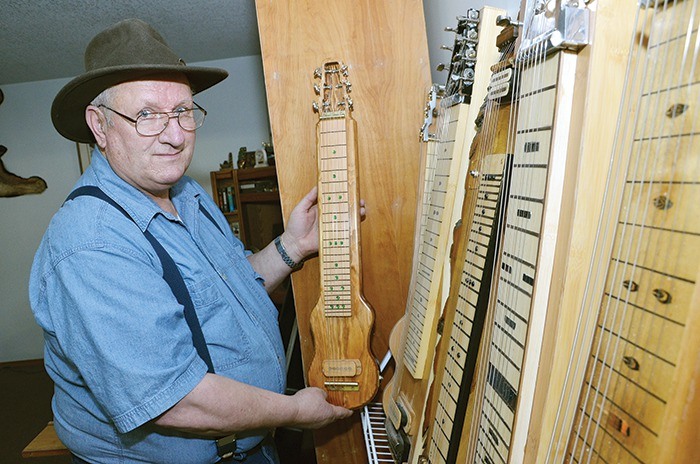Although his weathered hands have seen countless cuts and callouses during his time spent as a guide outfitter, mine worker and rancher, Doug McKay’s fingertips have harnessed the power of bamboo to create inertia in a way that can only be described as beautiful.
The 67-year-old woodworker has been constructing elegant fly fishing rods and bamboo lap guitars for the past 14 years.
“I do it as a hobby and it is very rewarding because of the finished product,” he said. “I am basically in love with it.”
An avid outdoorsman, the Invermere man began his creative cast by building graphite fly fishing poles. Not satisfied by the limitations of graphite as a material, a friend recommended that he experiment with the extremely hard, yet versatile bamboo.
After reading up on the process and building a few prototypes, Mr. McKay found himself hooked and immediately started designing his own workshop.
“I have built all my own tools except for my lathe and milling machine,” he explained. “All of the tools, planing forms and binders I built myself. That was really rewarding to be able to start from scratch and make everything.”
Doug charges $100 per each foot of his custom fly fishing poles, which take him on average 80 hours to complete. The process starts with a 12-foot section of Tonkin cane bamboo imported from China.
“The cane that we use for the rods comes out of the Tonkin Mountains in China,” Doug added. “It grows at a certain altitude, moisture content and temperature level that creates this cane that has super thick power fibres in it.”
Each section of bamboo is hung in the craftsman’s shed for a year to dry out properly before the build process begins. Once a piece has shed its excess moisture, Doug cuts thin strips from the bulk section of bamboo and then files down the nodes (seams) of each strip until they are flat.
The grass guru then uses a low intensity flame torch to darken the piece of bamboo and chase out excess moisture in the stock. Once the section has been darkened the wood is then split again into six short strips, which will make up a single section of the fly rod. Doug then files each section again to remove filler bamboo material (called pith) in favour of stronger power fibres that lie near the centre of the strip.
Any knots or seams in each strip are then smoothed out again in a vice. Each strip is placed in a triangular form and planed until it resembles a long smooth triangle strip. Once the rough planing is completed, the process becomes even more intricate as Doug adjusts the form to widen one five-thousandth of an inch for every five inches of the form. With the form set using a precise dial gauge, which is able to measure microscopic changes in width, each strip is carved to slightly widen from the tip to the bottom of the rod.
“You have to measure the piece regularly to make sure that you keep everything neat,” he said. “You try to get everything as close as possible, but it’s really easy to make a mistake.”
Six filed piece are then glued together to create each section of the rod (the average rod varies from a two piece to four piece). The glued pieces are then put through a spooling machine that Doug built himself. The woodworker feeds the glued sections of the rod into a circular opening in the machine, which tightly wraps two spools of string around the rod to bind the six sections together during the glueing process.
After gluing is completed, the designer puts each section of rod through a special varnishing system that he also designed himself. He has cored a four foot hole into his basement floor, which is filled with varnish. Each rod is hooked up to a barbecue rotisserie motor and pulled out of the floor at rate of 2.5 inches per minute.
When the rod is varnished, Doug builds his own cork grips, reel seats and ferrules (the metal attachments that connect each section of rod.
“After all that is done you put the guides on and then put the finish on the guides and you have got a rod,” he said.
In addition to Doug’s rod collection he has also built six lap guitars out of a mixture of woods, but bamboo is a grass the artisan finds hard to surpass.
“I have built a few guitars out of bamboo and the sustain is really incredible because the wood is so hard it resonates much longer,” Doug added. “I have always enjoyed steel guitar music, but I am a lousy musician and I don’t play much, but I enjoy the building side of it.”
